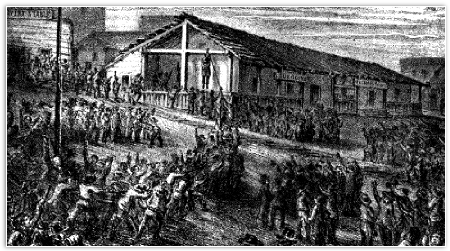The
1851 Committee of Vigilance
 This
drawing represents the outcome of the first trial and sentence of a criminal
by indignant citizens who took the law into their own hands to suppress
the crimes that flooded the state. This
drawing represents the outcome of the first trial and sentence of a criminal
by indignant citizens who took the law into their own hands to suppress
the crimes that flooded the state.
The
courts were apparently in the hands of the politicians and riffraff of
the city, who used the processes of the law for their own profit. There
were many murders between 1849 and 1851, but the perpetrators readily escaped
punishment and hangings were rare. The ballot box and the city administration
of justice was a farce. The indignation of the better class of citizens
was at fever heat.
On
June 9, 1851, at Sydney cove, John Jenkins walked deliberately into a merchants
store, picked up the small safe, carried it to a boat at a nearby wharf
and coolly rowed out into the bay. The alarm was given, and a number of
merchants pursued an overtook the man. He threw the safe overboard. Jenkins
was brought back and taken to a building that occupied a corner at Sansome
and Pine streets, the site on which the Royal Insurance Building is now
located. The prisoner duly tried by a jury and condemned to be hanged.
The
impromptu Vigilance Committee wasted no time, and the execution took place
in the Plaza the same night at 2 a.m. This prompt action had its effect
on the criminal class, and for a while they remained under cover.
San Francisco News Letter
September
1925
Return to the top of the page. |
 This
drawing represents the outcome of the first trial and sentence of a criminal
by indignant citizens who took the law into their own hands to suppress
the crimes that flooded the state.
This
drawing represents the outcome of the first trial and sentence of a criminal
by indignant citizens who took the law into their own hands to suppress
the crimes that flooded the state.